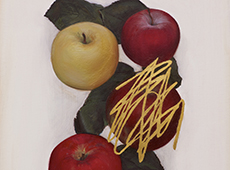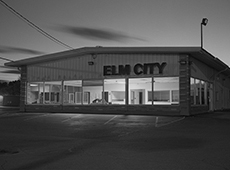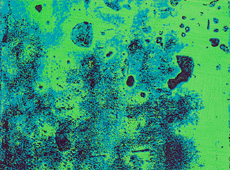I felt then, and still feel now, that the best art is internally complex. Even though my technique at the time was essentially reductive (flat colors, clean edges), I was trying my best to avoid simplicity. Minimalism was not, as I saw it, boisterous or contradictory enough to be of life. Maximalism was my chosen mode. More, it was my mantra.
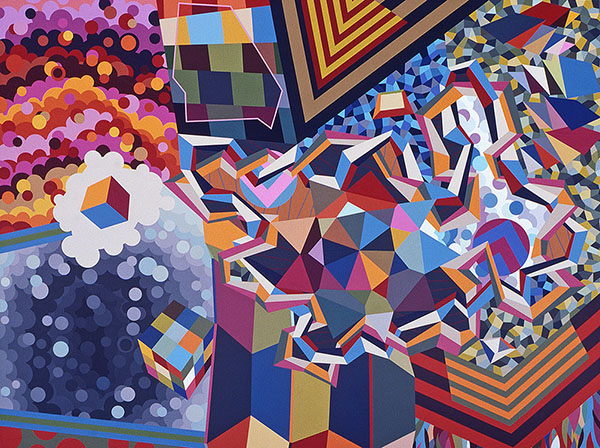
Zachary Keeting,
This painting dates from 2000. I was a couple of years out of grad school, and had just made the strange decision to move back in with my mom. All of my sisters were away at college, so it was just the two of us in the suburban house where I’d grown up. She’d been through a difficult divorce; I was helping her organize, downsize, start over. I spent the majority of my time painting (hiding out) in the garage, doing my best to avoid serious employment. For a twenty-seven year old, this wasn’t a particularly healthy social transition: all of the friendships, all of the connections I’d made at school, evaporated. I spent those days up in my head, and the art illustrates that. Looking back I wouldn’t recommend it. That said, my mom appreciated having me around.
All of the paintings I made that year were intensely claustrophobic. At one point, for emotional escape, I bought a two-month open Greyhound bus ticket. I loaded up a backpack with 35mm film and hit the road.
There’s a motif at the top of this painting that directly alludes to an experience I had in Atlanta. The racetrack-like form is a simplified map of Georgia, a state I’d lived in briefly as a child. I had been looking forward to revisiting Atlanta, but I ended up getting mugged at gunpoint on the street. Thankfully, I made it out unscathed. The experience was curious: while I was being assaulted, my mind disengaged. My eyes stopped working, all I could think of, all I could see, was Octavio Paz’s short story, “The Blue Bouquet.” The narrative arc of that piece, what I’d envisioned years earlier while reading it, filled my mind, blotted out all else. As my assailants cleaned me of cash and camera, my mind wandered. Afterwards, I was oddly calm.
I felt then, and still feel now, that the best art is internally complex. Even though my technique at the time was essentially reductive (flat colors, clean edges), I was trying my best to avoid simplicity. Minimalism was not, as I saw it, boisterous or contradictory enough to be of life. Maximalism was my chosen mode. “More” was my mantra.
Eight weeks later, broke and exhausted, back in the garage, my head full of the American West, I tried to make paintings as functional as that story: successful coping machines.
I felt then, and still feel now, that the best art is internally complex. Even though my technique at the time was essentially reductive (flat colors, clean edges), I was trying my best to avoid simplicity. Minimalism was not, as I saw it, boisterous or contradictory enough to be of life. Maximalism was my chosen mode. “More” was my mantra.
Off to the left, there’s a mixed up Rubik’s Cube dreaming of a fixed Rubik’s Cube. I was never any good at solving those damn things. This toy, and my inability as a kid to bring the colors in-line, came back as a symbol of general confusion, of weakness, of ineffectual potency. I thought of this as kinda funny. In other paintings, fixed Rubik’s Cubes were rendered hollow, phony; it’s the mixed up ones that remained substantial, opaque, believable.
Military stripes slip from the top and fall off the bottom. I often thought of my father, who died when I was young in an F4: the strength fighter pilots symbolize, the damage they do.
There’s a crystalline DNA structure at the core of this piece surrounding pinwheels and circular arrows. I had hoped to convey a sense of wandering, a sense of traveling widely with inescapable thoughts, of being shadowed at every turn. Repeated patterns were meant to be reassuring, understandable. Chaotic, non-repeating patterns were included as counterpoint; a stab at unpredictable naturalism.
I have come to admire layered Robert Altman scenarios: overlapping voices, overlapping thoughts, crosscurrents and contradictions, group energy. I take from him amplified complexity, and add overt concealment, noxious fluidity, radical balance: choreograph multiple personalities in every scene, raise a thoughtful ruckus.
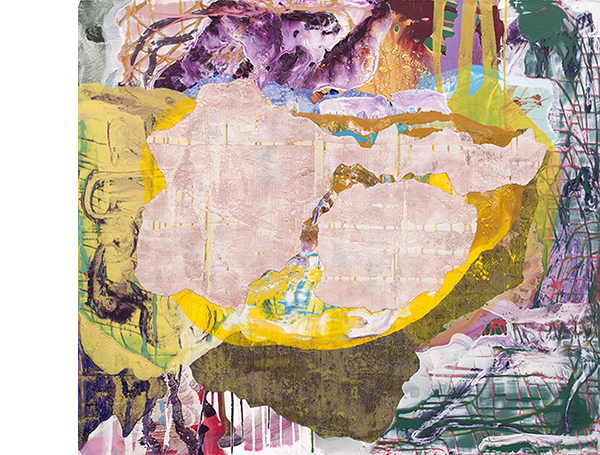
Zachary Keeting,
© Zachary Keeting. Courtesy of the artist.
I tried in this and other paintings from the time to be bravely open, to foreground the content, avoid cryptic disguises. The good ones had unforgiving clarity and embarrassing nakedness. In some ways, the paintings have changed dramatically since then, but there’s much that has remained consistent. The surfaces are now riddled with overt gesture, yet they’re still built slowly. I punch, scrape, shake, blot, pour, and stain, but a great amount of thought goes into spatial orchestration, to the arrangement of charismatic zones, where one form touches (or avoids) another. I have come to admire layered Robert Altman scenarios: overlapping voices, overlapping thoughts, crosscurrents and contradictions, group energy. I take from him amplified complexity, and add overt concealment, noxious fluidity, radical balance: choreograph multiple personalities in every scene, raise a thoughtful ruckus.
And the difficulties of communicating content within this arsenal of movement: how accurate and representative can the contour of a spill be? Who can be summoned with a turn of the wrist, with a rapidly plunging line? Do these abstractions contain heat, can they represent longing? I want the pieces to be unabashedly sensuous. Does the improvisational energy overshadow the specificity of subject?
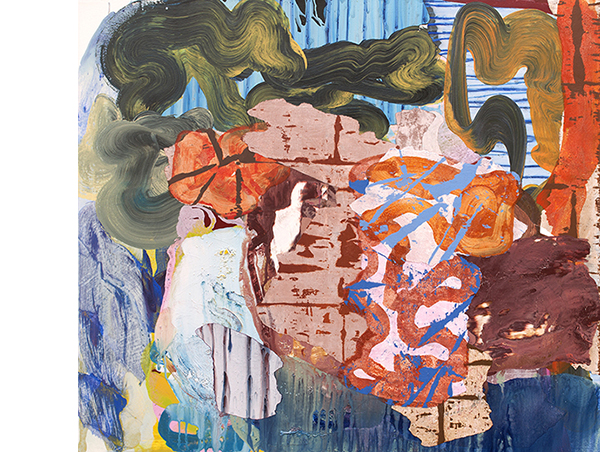
Zachary Keeting,
© Zachary Keeting. Courtesy of the artist.
Zachary Keeting & Anahita Vossoughi: Rockless Volume opens at Fred.Giampietro’s new exhibition space (1064 Chapel Street, New Haven), Saturday 10 January. (Through 21 February.)
Editor’s Recs:
Zachary Keeting at Fred.Giampietro, reviewed by Julian Kreimer (Art in America, 12/17/2013)
Keeting and Grill: Timeless energy; Zachary Keeting and Clare Grill at Fred.Giampietro, reviewed by Sharon Butler (Two Coats of Paint, 9/25/2013)
Zachary Keeting in conversation with Brett Baker (Painters Table, 9/10/2013)
Gorky’s Granddaughter, Zachary Keeting and Christopher Joy’s documentary art project. (A favorite here at Tilted Arc)
Artist’s site: zacharykeeting.com
Subscribe to Tilted Arc
If you like this story, please consider subscribing. We are sticklers for privacy.
We will never sell or share your e-mail address.

